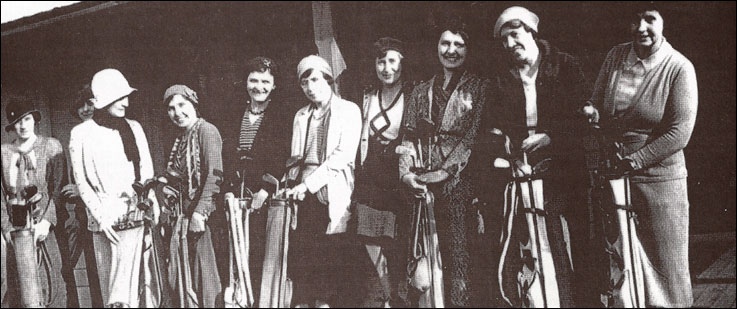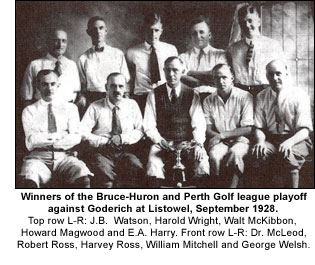Club History
100 years of golf at the
Kincardine Golf Club!
by Lynda Janzen

Kincardine's Women in Golf from 1925: L-R: Ruth Marcus, Nan Morrison, Ethel
Malcolm, Estell Cottrill, Blanche Bruce, Cosey Magwood, Tommy Magwood, Sadie Welch, Glad Chowem and Mona Helliwell.
Back in 1906, Josephine Gualco, a native of Kalisz, Poland, purchased
a piece of property in Kincardine on which she and her friends could play a game which had recently been introduced to Canada. That game was golf and that property became part of what is known today
as the Kincardine Golf Club.
A forerunner of today's golf scene was introduced by one of Madame Gualco's friends, Dr. MacCrimmon. The doctor had a physical infirmity which made walking onerous,
so he would drive his horse and buggy over the course, getting out of the buggy to hit his shots, and then on to the next ... a preview of the modern-day golf cart!
The original course consisted
of four holes, including one known as the 'Hospital Hole'. Lawn mowers and motorized groomers were still a long way into the future, so originally, sheep were encouraged to graze on the fairways and
greens, not only keeping the grass short, but green as well!
In 1920 the Club was incorporated as the Kincardine Country Club (Private) Ltd., although most people, including those who work
there, use the more familiar term 'Kincardine Golf Club'. In July of 1920, a deputation from Kincardine sought out the Reverend David Ritchie at his manse in Cromarty to ask for his help in
developing the Kincardine Golf Club's course. Rev. Ritchie was born in St. Andrews, Scotland in a house overlooking the Royal and Ancient Golf Links. From the age of three, golfing had been second
nature to him. The Ritchie family emigrated to Toronto where, as a youth, he worked for the registrar of the University of Toronto, Dr. Brebner. An avid golfer, Dr. Brebner enlisted David Ritchie's
natural talent for the game which led to a job as Pro at the Rosedale links, a job that by Lynda Janzen financed Ritchie's university tuition.
David Ritchie's design included enlarging the
course and laying it out in a challenging configuration. In 1929, land was purchased to make two new holes, the practice field and parking lot. Then, in the early 1930s, the new holes were laid out
and the greens built. A row of trees dividing these fairways was planted by D. A. Sutherland, principal of the High School at that time. Long-time members will remember him calling out in a very loud
voice, "Whoa, Emma!" whenever he hit the ball too hard while putting.
Numerous improvements have been made over the years, with greens enlarged and built up, new sand traps installed. and, most
importantly, irrigation for the fairways. Before irrigation, it was a tremendous job to keep the course green in high summer.
In the 1930s, Sandy Howie, also a Scot and a great teacher, joined
David Ritchie who was beginning to slow down. That was about the time the game was changing from using wooden sticks to steel shafted clubs, with which Sandy Howie had more than a passing
acquaintance.
 Kincardine resident, Alice Seymour, nee Malcolm, recalls having had lessons from Sandy
Howie, over 72 years ago! Alice says her mother had been a good golfer and encouraged her children to play. Golf was a large part of the fun and mystique of summer for the Malcolm family. Kincardine resident, Alice Seymour, nee Malcolm, recalls having had lessons from Sandy
Howie, over 72 years ago! Alice says her mother had been a good golfer and encouraged her children to play. Golf was a large part of the fun and mystique of summer for the Malcolm family.
Following, Sandy Howie came a Pro by the name of Mal Polhill, an excellent player, but by all accounts, not what you would call a patient teacher. One member recalled getting a crack across the
knee with a golf club for not doing what she was told!
Around the mid-1930s, Peter McCallum became the Club Manager and Edward Skipper was made Groundskeeper. Following Skipper's retirement,
Ryerson Robinson, equally devoted to the Club, did the job for many years. From the age of 12, Jim Bell helped his grandfather Ryerson during summers. This training gave him the know-how to keep the
course in good condition and the club running smoothly, preparing him well for the job of Club Manager, a job he has held since1964. The current Groundskeeper is Gord Howse.
During the 1920s and
30s, the little room at the north end of the old clubhouse was the pro shop where you paid your greens fees. The Pro Shop was run by various young members, over the years, including Sutherland
Malcomson, Bill Bruce, Burdett Magwood and Walton "Stork" McKibbon.
In the 1950s the 8th tee became the 1st tee and a small Pro Shop was built. Current Director Ann Lichtenberg's father, George
Morrison, a former Postmaster, took over the collecting of green fees in the 1950s. A long-time golfer at the Club, George had already introduced Ann to the game in the 1940s. When George retired,
his brother Frank took over and carried on the job for ten years.
Jim Bell's sister Judy Hunter recalls the two of them on the golf course from a very early age. In her words, "We grew up on the
golf course." Judy remembers her mentor, Peggy Malcolm, who took Judy under her wing when she realized the girl had a passion for the game that matched her own. Judy says Peggy was a wonderful lady
and a fine golfer. "She was always there to take me out golfing and to tournaments." At that time, Judy says, she played golf in her bare feet. But when she got good enough to take part in
tournaments, Peggy and the other ladies told her she couldn't play in bare feet, that she had to have shoes. Her Grandpa Ryerson got her a little pair of cleats for her first tournament.
Ann
Lichtenberg says during the 1940s and '50s, players would come off the 9th green to have a sandwich and a piece of lemon pie made by Mrs. Ryerson (Lillian) Robinson and friends. The lemon pie became
somewhat of a tradition at the Dr. Ritchie
Kincardine Golf Club, endearing the ladies to all who played the links.
All during the summer the cottage people from Bruce Beach and Huron would
come in to play golf and they'd buy up all the pies ... mostly lemon, but also butterscotch and apple pies. When Judy was 12 she began to work for her grandma Lillian baking pies. Her brother Jimmy
would get to know all the cottagers and the kids would play golf together.
One summer, Lillian was making pies when her diamond ring went missing. Everyone looked for it all that summer but it
was never found. The following spring, Joe Furridge was burning garbage out by the wood pile and saw something sparkling in the ashes. It was the diamond ring that somehow had got thrown out with the
garbage.
Golf is a family activity in the Bell and Hunter families.
Judy's husband Charlie (who is a great, great, great grandson of Paddy Walker) says he played reluctantly, when he first
took up the sport, but soon got into the groove. Charlie says their children all took up the game at the tender age of two. Charlie is a Director of the Kincardine Golf Club, and he and Judy are both
on the planning committee for the centennial celebrations scheduled for August 4th, 5th, 6th and 7th.
It will be a weekend of tournaments and other fun, beginning with a Junior Nine-Hole
Tournament, teeing off at 9 am on the Friday.
Over the years, a number of celebrity golfers have graced the links of the Kincardine Golf Club, including the great Sandy Somerville. Known as the
gentleman golfer, Somerville not only won the 1932 U.S. Amateur, a first for a foreign golfer, but betweenl926 and 1937, he captured six Canadian Amateurs, a record that may never be equalled.
The Kincardine Golf Club has produced a prodigious number of good golfers in its 100 year history. Mostly, though, duffers come out just to have some fun and exercise, and to socialize with other
golfers. They've been doing so for a century. It's a pretty good bet they'll be playing golf at the Kincardine Golf Club for at least another hundred years.
Congratulations, Kincardine Golf, for
100 years of great golf!
| 
